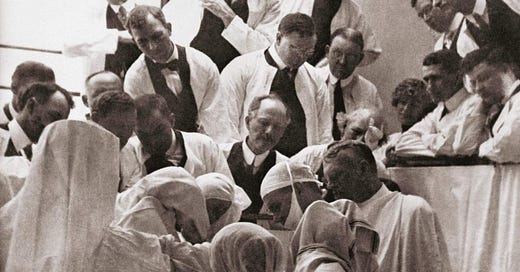Five Best: Books on Inventors and Innovators
My Top 5 Books on Innovation - As Featured in Today's WSJ.
Read in WSJ: Five Best - Books on Inventors and Innovators
Charles Mayo, of the Mayo Clinic, demonstrating a surgical procedure in 1913. Photo: GRANGER
The Doctors Mayo
By Helen Clapesattle (1941)
1. Geography played a part in spurring innovation at the Mayo Clinic, which opened its doors in 1889 in Rochester, Minn. Out of the shadow of the leading medical centers in Baltimore, Boston and New York, the brothers and surgeons William and Charles Mayo developed a revolutionary organizational model for treatment. As Helen Clapesattle writes in “The Doctors Mayo,” every patient at the Mayo brothers’ multispecialty facility was a patient of the entire clinic and not of any individual doctor. Charles believed that in order for the sick to “have the benefit of advancing knowledge, union of forces is necessary.” A network of pneumatic tubes was built to deliver patient records to physicians across the facility in minutes. This same system supported another innovation: pausing surgeries while biopsied tissue was dispatched to the clinic’s pathology laboratory for immediate analysis. Yet another Mayo innovation, dating to 1907, was to keep uniform patient histories. The clinic’s extensive archive—initially preserved on paper and now digitally—continues to serve researchers today.
Longitude
By Dava Sobel (1995)
2. The ranks of innovators are crowded with obsessive heroes. Dava Sobel’s “Longitude” tracks John Harrison’s 43-year quest to give sailors a crucial tool for navigating the seas. As the 18th century began, shipwrecks bedeviled European explorers. In 1707 sailors of the British fleet “misgauged their longitude” and sunk four warships off southern England near the Scilly Isles, making the isles “unmarked tombstones for almost two thousand” men. After that wreck and others that followed, Parliament established a £20,000 prize (over $4 million today) for anyone who could devise a method to measure longitude at sea accurately. Latitude can be easily determined by referring to the stars. Longitude, however, requires reference to the difference in time between the ship’s position and the port from which it left. The solution lay in inventing a device to measure time accurately—a sea-going clock. At the time, the most sophisticated clocks required pendulums, a mechanical solution incompatible with a rolling ship at sea. Harrison, a carpenter and clockmaker, crafted three ingenious clocks without pendulums. “His every success, however, was parried by members of the scientific elite,” Ms. Sobel writes. Harrison’s fourth attempt, a sea chronometer produced in 1759, resembled a large pocket watch and won Parliament’s prize. A 1783 update of his invention ruled the waves until GPS technology became available in 1983.
The Medieval Machine
By Jean Gimpel (1976)
3. “Between the tenth and the thirteenth centuries, Western Europe experienced a technological boom,” the French historian Jean Gimpel writes in “The Medieval Machine.” Gothic cathedrals emerged, along with eyeglasses, the weight-driven mechanical clock and the science of crop rotation. “The ambition of inventors was unlimited, their imagination boundless,” according to Gimpel, who defines innovation as nonstop experimenting to increase productivity. The heavy-wheeled plow, another marvel of the era, exemplifies such thinking. Its deep furrows brought more fertile soil to the surface, yielding larger harvests. European innovators harnessed water and wind to save human and animal energy. Gimpel documents how dams and water wheels were built, transmitting power to the millstones, grinding wheels, carding machines, and hammers that beat linen and cotton rags into the slurry that would become paper. Dutch settlers brought the windmill to New Amsterdam; now this triumph of innovation is memorialized in the seal of New York City.
The Dawn of Innovation
By Charles R. Morris (2012)
4. In the War of 1812, the United States and England clashed in naval battles for control of Lake Ontario. The new nation prevailed, thanks in part to massive, ocean-worthy warships built deep in the North American wilderness. Charles R. Morris enlists this history in “The Dawn of Innovation” to illustrate two habits of innovators. The first is tinkering, or testing big ideas on a small scale; the second is thinking about problems differently, or, as the British historian Herbert Butterfield put it: “picking up the opposite end of the stick.” Innovation dawned in the 19th century because America had invented a new economy—the world’s first “mass-consumption society,” as Morris calls it. “Machinery-intensive methods of manufacturing guns” for the U.S. Army fostered progress in precision measurement, advanced machining and parts production. Gun makers including E. Remington & Sons diversified into producing typewriters, locomotive parts and gears for the nascent bicycle market. Bicycles in turn inspired Henry Ford and the Wright brothers, whose inventions changed history.
Where Good Ideas Come From
By Steven Johnson (2010)
5. “Chance favors the connected mind,” Steven Johnson writes in “Where Good Ideas Come From,” and innovation thrives when good ideas connect. Innovators embrace chaos as a habit of mind, firm in their belief that this is how new ideas are born. Among the innovators—and connected minds—Mr. Johnson cites is an engineer named Willis Carrier. In 1902 Carrier was tasked with solving a problem at a Brooklyn, N.Y., plant that printed magazines, catalogs and other publications. A recent innovation in printing—colored ink—proved unstable on humid summer days, causing pages to wrinkle and delaying production. Carrier focused not on the ink but the high humidity levels inside the printing plant. To dry the air, he figured, the building’s interior temperature had to be lowered. Air conditioning was born. “Carrier’s narrative fits the classic mold of the genius entrepreneur,” Mr. Johnson writes. “After experimenting with a handful of failed schemes suggested by his colleagues, Carrier followed his own instincts” in building prototypes to cool the air. Early adopters of his invention included food-processing plants, theaters and hospitals. By the second half of the 20th century, air conditioning, Mr. Johnson writes, “went from a curiosity to a luxury item to a middle-class necessity.”




